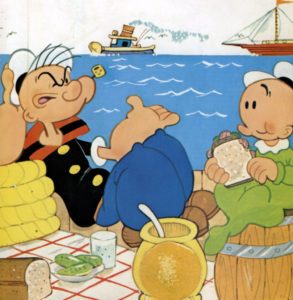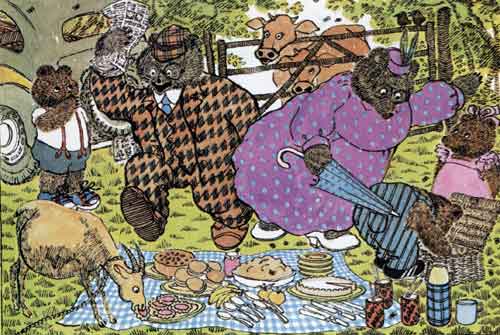In picnic stories, unlike real-life children who are often persnickety, there are no arguments about food choices. Most importantly, most juvenile stories associate fun with baskets full of sweets, carbs, and fats. Presumably, well-behaved children require tasty comfort food.
Picnic narratives for children are formulaic: (a) anyone can picnic, and sooner or later, everyone does ; (b) people go on picnics mainly for the fun, freedom, love, and charm of it ; (c) picnickers expect a perfect day for a picnic; (d) the outdoors is preferred to indoors; (e) picnics are held in backyards, parks, beaches, gardens, rooftops, or parlors—wherever a space can be found to spread a blanket or set the table and chairs; (f) picnics are most often casual and require minimal paraphernalia –a blanket and a food basket a paper bag ; (g) picnic foods include sandwiches, sausages, frankfurters, cakes, cookies, and soft drinks.
This picnic food pattern, almost incorruptible, began not long after the first picnic stories at the turn of the 19th century, in which comfort food was not predominant.
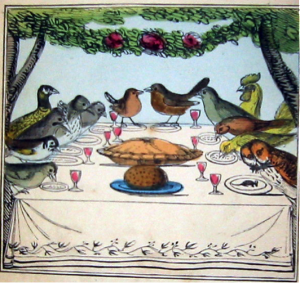
The Happy Courtship, Merry Marriage, and Pic-nic Dinner of Cock Robin and Jenny Wren edition. The illustrator is unknown. 1813
John Harris’s food for the 1806 fable The Happy Courtship, Merry Marriage, and Pic-nic Dinner of Cock Robin and Jenny Wren is idiosyncratic. Though Robin brings currant wine and cherry pie, Sheep brings wool (presumably for Robin and Jenny to nest in). However, Raven brings walnuts; Dog brings a meaty bone; Owl brings wheat; Pigeon brings tares (greens; Squirrel predictably brings nuts; and Magpie brings cheese. Only Little Mary, a girl (accompanied by her mother), brings cheese, apples, bacon, and plums. The outrageous menu for Mary Belson Elliot’s 1809 The Mice and their Pic Nic is epicurean because it’s served in a London townhouse. The dinner served to a group of country bumpkin mice used to corn kernels and acorns are served cold soup, sweetmeats, and fricassee chicken, cold bacon, pickles, whipped cream, plumb-cake, cheesecake, custards, and Cheshire cheese.
Of the foods served, Little Mary’s cheese, apples, bacon, and plums, and Elliott’s whipped cream, plumb-cake, cheesecake, and custards became standards.
The shift to the power of sweets is evident by 1867 in Mark Twain’s The Adventures of Tom Sawyer. When Tom Sawyer and Becky Thatcher leave their rollicking picnic and get lost in McDougal’s Cave for an hour, they eat “wedding” cake to stave off hunger. The picnic basket in Stella Austin’s popular but long-forgotten Stumps is all comfort food: apple tarts, plum cake, shortbread, mulberry tart, sponge cake, bread and butter, hard-boiled eggs, plums, pears, greengage plums, macaroons, and Stumps favorite “trawberry jam.” Frances Burnet Hodgson’s The Secret Garden picnics menu is a crusty cottage loaf, currant buns, roast eggs, and potatoes garnished with butter and salt. Kenneth Grahame’s picnic basket in The Wind in the Willows is enough to induce heartburn. It’s crammed full of stuff that Water Rat can scarcely lift it.
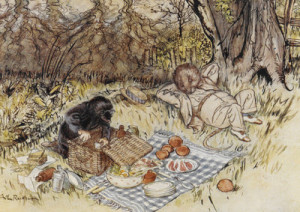
Arthur Rackham. “The Mole Begged as a Favour to be Allowed to Unpack it all by Himself,” in Kenneth Grahame’s The Wind in the Willows (1940)
We laugh at Ratty’s “coldtonguecoldhamcoldbeefpickledgherkinssaladfrenchrollscressandwidgespottedmeatgingerbeerlemonsodawater” –but it’s enough to feed Ratty’s friends, and probably of the voracious weasels, too. A second skimpier picnic is more for adults and is comprised of a loaf of French bread, sausage, and wine. But no one pays much attention to it. Winnie the Pooh likes honey and little cake things with pink icing. The honey is natural, but it’s a carbohydrate, after all. Before they pass out on a sandbar in the English Channel, the Pott family in Ian Fleming’s Chitty Chitty Bang Bang devours a basket of “hard-boiled eggs, cold sausages, bread-and-butter sandwiches, jam puffs and bottles of the best fizzy lemonade and orange soda.“
The pattern rarely subsides or changes much. Jacqueline Woodson’s We Had a Picnic This Sunday Past is a joyous family gathering with lots to eat Biscuits, fried chicken, sweet corn, cinnamon bread, cranberry muffins, sweet potato pie, peach cobbler, yams, potato salad, salad, a baked ham, cornbread, homemade ice cream, and cousin Martha’s store-bought cake.
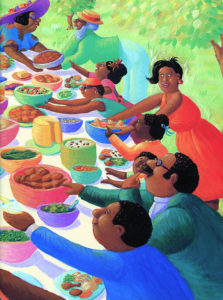
Diane Greenseid. “Then Mr. Pete came running—” In Jacqueline Woodson. We Had a Picnic This Sunday Past 1997
Margaret Gordon ratchets up the food intake in Wilberforce Goes on a Picnic – detailing a family of obese bears whose blue gingham picnic blanket is chockablock with hamburgers on rolls, sandwiches, a jar of catsup, a bowl heaped with mashed potatoes, bananas, yellow fruit (of some kind) a pie (contents unknown), a cake (perhaps cheesecake covered with nuts), a plate of tarts with some pink filling (maybe strawberries) Having passed out from eating, the family awakens to make the ride home—to a scrumptious dinner—before getting into bed Ronda Armitage and David Armitage’s The Lighthouse Keeper’s Picnic suggests that Mr. Grinling, the lighthouse keeper, must lose weight But indelible Image taken away from this Grinling’s is the book’s centerfold, two pages of hamburgers, hot dogs, beef or lamb kebabs, pizza, scallop sausages, crab salad, sandwiches, melon, layer cake, cream whorls, green jelly, melon, grapes, bananas, pears, apples, peaches, cupcakes, Danish pastry, cherry tart, chocolate éclair, ice cream with whipped cream “Delicious and delectable,” the ecstatic Mr. Grinling murmurs when he can take a breath.
Cookbooks rely on standard comfort foods. Some authors do offer sound advice about eating for good health and taste, But in the language of comfort food, if it ain’t sweet, it ain’t upbeat, cheery, and satisfying Typically, a menu will suggest pink lemonade with strawberries, cheese rolls, apple and bacon sandwiches, and cherry tomatoes with clover-honey dressing, ambrosia fruit salad, caramel-nut popcorn, candy, and cookies Winnie-the-Pooh’s Teatime Cookbook, Inspired by A. A. Milne is a powerful unrivaled collection of comfort foods without constraints: Breads and Toasts, Scones, Muffins, and Crumpets, Jams and Butters, Sandwiches, Cookies and Biscuits, and Cakes and Pastries.
A hunt is required to find alternative menu suggestions. The foods in Brunhoff’s Babar’s Picnic are vegetarian. Babar, Celeste, their children, cousin Arthur, and their friend the Old Lady dine on smallish portions of bananas, pears, apples, grapes, and sandwiches, contents unknown. Olive Oyl has perversely prepared two picnic baskets packed with salami, fresh rye bread, pickles, root beer, and lemonade. The meal is graciously declined by Popeye, an unlikely gourmet, who demurs, “No, thanks, Olive, I’d rather have spinach.”
